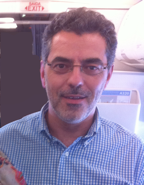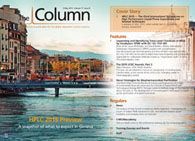Novel Strategies for Biopharmaceutical Purification
The biopharmaceutical industry continues to expand in response to a demand for novel biopharmaceuticals. José Paulo Mota from the Faculty of Science and Engineering (FCT-UNL) of Universidade Nova de Lisboa and the Institute of Experimental and Technological Biology (IBET), Portugal, has been working on the development of chromatographic techniques to speed up the purification of biopharmaceuticals, specifically adenoviruses. Bethany Degg of The Column spoke to him about his work.
The biopharmaceutical industry continues to expand in response to a demand for novel biopharmaceuticals. José Paulo Mota from the Faculty of Science and Engineering (FCT-UNL) of Universidade Nova de Lisboa and the Institute of Experimental and Technological Biology (IBET), Portugal, has been working on the development of chromatographic techniques to speed up the purification of biopharmaceuticals, specifically adenoviruses. Bethany Degg of The Column spoke to him about his work.
Photo Credit: Science Photo Library - PASIEKA/Getty Images

Q: What are the main research interests of your group?
A. The majority of biopharmaceuticals are now produced in large-scale animal cell cultures. The ever-increasing demand for these biopharmaceuticals requires highly productive bioprocesses and shorter development timelines. We have been studying the mechanisms underlying cell growth, cell metabolism, and product formation to rationally develop and optimize production processes of recombinant proteins (including monoclonal antibodies), viral vectors for gene therapy, and several viral vaccines.
To support and speed up the different phases of bioprocess development at both upstream and downstream levels we have been developing several processes and tools, namely: (a) recombinaseâmediated cassette exchange systems in cell line development; (b) tools for highâthroughput screening in earlyâstage phases of bioprocess development; (c) tools for realâtime bioprocess monitoring; and (d) tools for rational development of downstream purification strategies.
Q. Adenoviruses are one of the most common platforms used for the development of gene therapy vectors and viral vaccines. Can you comment on the reasons why this is the case?
A. Adenoviral vectors are presently the most widely used vectors in gene therapy clinical trials to target pathologies of different origins, such as cancers, infectious diseases, or neurological disorders. Human adenoviruses (hAv) are generally the chosen prototype vector backbone. A platform for production, purification, and storage of such vectors was developed in our group.
One of the major hurdles regarding the use of hAv is the pre-existent immunity memory that may limit the efficiency of transgene expression in humans. To circumvent this, non-human adenovirus vectors such as Canine Adenovirus Vectors type 2 are being developed and studied by our group. The restricted experience in the field with these vectors requires the establishment of an entire process development suitable for GMP manufacturing. Current objectives include the development of canine transcomplementing cell lines that support the amplification of the vectors and also the development of upstream and downstream processes.
Q. What are the main chromatographic techniques used for the purification of complex biopharmaceuticals and what are the challenges?
A: Liquid chromatography (LC) is clearly the core technique for viral vector purification. The main chromatographic techniques used for the purification of complex biopharmaceuticals are ion-exchange chromatography (IEC) (both in capture and follow-through modes), sizeâexclusion chromatography (SEC) (frequently, as a final polishing step), and, less frequently, affinity chromatography. The complexity of biological products, such as Ad5 vectors, has been hampering the development of robust downstream processes. Obtaining the quantities required for preclinical and clinical trials is especially problematic. The development of scalable processes has been identified as critical for the generation of recombinant viral vectors for clinical applications.
As a result of the intricate nature of these biological particles, there are critical implications on the downstream processing concerning purity, potency, and quality of the final product. The downstream processes should therefore be designed to accommodate these requirements according to the final application. Often, a sensible compromise must be made between cost, throughput, and purity to meet both the quality and potency aimed at in a given preâclinical or clinical trial.
Q: What are the key considerations when designing and validating methods for industrial use?
A. The goal of any integrated biomanufacturing process is to deliver the product in large quantities (scalability), with high quality (purity), and in high titre (potency), and doing so in a cost-effective manner. The key considerations are clearly robustness (the design space must be fairly large) and costâefficiency.
Q: You and your team recently published a method using two-column, size-exclusion, simulated countercurrent chromatography method for the purification of adenovirus. Can you discuss the main principles of the method and why it offers advantages over existing methods? What developments are needed for the method to be adopted by industry?
A. Presently, most biochromatographic processes are still largely operated in batch mode. Typically, the target product is separated from process-related impurities through a series of steps where a selected cut or fraction of the effluent from the previous step is selectively adsorbed and desorbed onto a given stationary phase using time and elution conditions as manipulated variables, until, ultimately, yielding the product purified to the desired level. However, batch chromatography suffers from high product dilution, low efficiency and productivity, and high solvent consumption.
As a general rule, multicolumn processes implementing simulated countercurrent (SCC) adsorption can achieve better performance than sequential batch chromatography. Moreover, since bioseparation does not impose the requirement that the separation scheme be continuous, it allows several possibilities and a multitude of operating modes to be considered in the design of the process, which otherwise would have to be excluded. In principle, a semi-continuous, multicolumn process can make use of various techniques to achieve the desired separation; for example, some columns can be dynamically interconnected, so that nonâpure product cuts are internally and counterâcurrently recycled, while other columns can be short circuited to operate in pure batch mode, and others frozen to introduce time lags between the positions of the various concentration fronts.
This way some fractions can be separated by a SCC approach (the mass-transfer zone is kept inside the system by means of the port switching and the remixing with the feed), while the separation of other fractions can be chromatographic (the mass-transfer zone is taken out of the system). By freezing one or more columns (in this instance, stopping the flow through them) for some steps of the cycle, it is possible to decouple the migrating velocities of the various solutes. Our method achieves this while working in a simple, openâloop system that resembles the batch system. The method as presented is best suited for isocratic separations.
Q: Carbon nanotubules have the potential to be used for the delivery of DNA to living cells. Can you discuss the developments needed for this novel drug delivery method to be used in the clinic?
A. We have fundamental, theoretical work on the use of carbon nanotubes as potential delivery systems of DNA to living cells. These carbon nanostructures are biocompatible and have a geometry and surface chemistry that favour the thermodynamics of DNA encapsulation and subsequent delivery of biological payloads to living cells under physiological conditions. Although this is very encouraging for technologies developing novel drug delivery agents, the use of carbon nanotubes needs to be cautiously considered at this stage of development. The confinement of DNA molecules must be a reversible process and the subsequent ejection towards the nanotube exterior triggered by changes in the surrounding physiological environment (typically pH or temperature) at a prescribed delivery rate. This is still at an early stage of development.
Q: Is there anything that you would like to add?
A. I cannot overemphasize the contribution of all my coworkers: Piergiuseppe Nestola, who defended his PhD thesis in December (2014), and Ricardo Silva (who received his PhD in December 2013) did all of the handsâon work. Cristina Peixoto is the head of the IBET’s Downstream Process Development Laboratory; she supervises the laboratory work and has over 20 years of experience on the downstream processing of viral vectors. Last, but not least, the former and current IBET CEOs, Prof. Manuel Carrondo and Dr. Paula Alves, make things happen and pushed this project forward. Fernando Cruz did all the work on DNA delivery by carbon nanotubes.

José Paulo Mota is full Professor of Chemical and Biochemical Engineering at the Faculty of Science and Engineering (FCT-UNL) of Universidade Nova de Lisboa, Portugal, and a member of IBET’s Animal Cell Technology Unit; IBET (www.ibet.pt) is a private not-for-profit research organization in the area of biotechnology and life sciences. José Paulo has over 100 publications in the fields of transport phenomena, separation processes, and process simulation, with a particular focus on adsorption science and technology. He is one of the world experts in the field of continuous chromatography and simulated moving bed (SMB) technologies. He is a member of the Scientific Council of Sciences and Engineering of the Portuguese National Science Foundation; the Board of Directors of the International Adsorption Society; and the Scientific Committee of the International Symposium on Preparative and Industrial Chromatography and Allied Techniques (SPICA).

Common Challenges in Nitrosamine Analysis: An LCGC International Peer Exchange
April 15th 2025A recent roundtable discussion featuring Aloka Srinivasan of Raaha, Mayank Bhanti of the United States Pharmacopeia (USP), and Amber Burch of Purisys discussed the challenges surrounding nitrosamine analysis in pharmaceuticals.
Silvia Radenkovic on Building Connections in the Scientific Community
April 11th 2025In the second part of our conversation with Silvia Radenkovic, she shares insights into her involvement in scientific organizations and offers advice for young scientists looking to engage more in scientific organizations.

.png&w=3840&q=75)

.png&w=3840&q=75)



.png&w=3840&q=75)



.png&w=3840&q=75)








